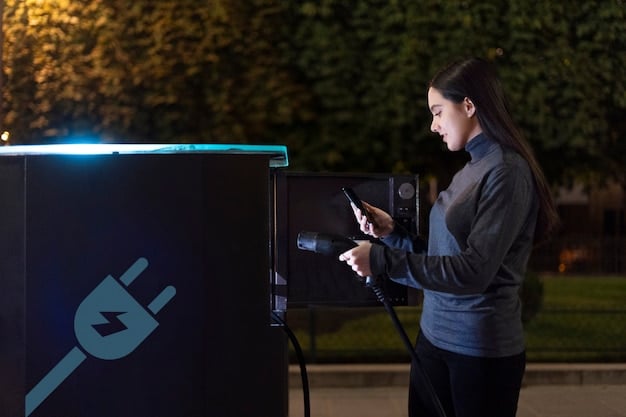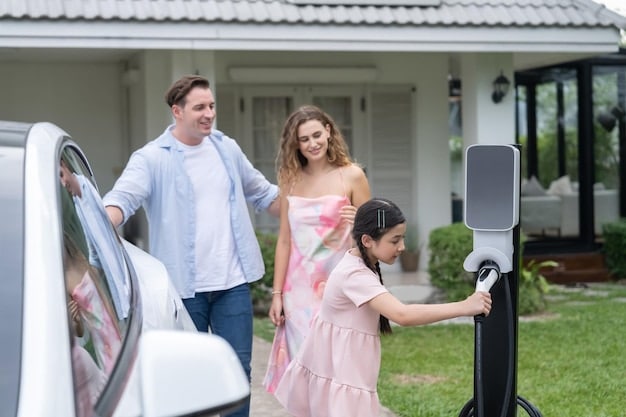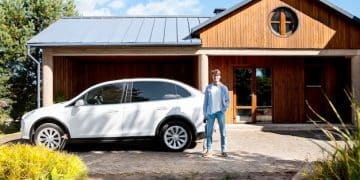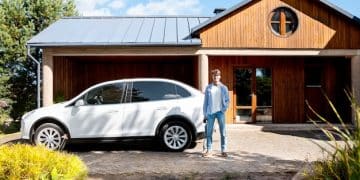New Federal Tax Credit: Impact on 2025 Electric Vehicle Buyers

The updated federal tax credit expansion significantly impacts 2025 electric vehicle buyers by altering eligibility requirements, increasing the potential credit amount based on battery component sourcing, and aiming to make EVs more affordable and incentivize domestic manufacturing.
The landscape of electric vehicle (EV) ownership is constantly evolving, and a key piece of that evolution is the **new federal tax credit expansion: how the updated electric vehicle incentive program impacts 2025 buyers**. For those considering purchasing an EV in 2025, understanding these changes is crucial.
Understanding the Updated Federal EV Tax Credit
The federal EV tax credit has undergone significant changes, particularly impacting models available and buyer eligibility. These changes aim to encourage domestic manufacturing and make EVs more accessible.
The previous tax credit had some limitations on vehicle price and manufacturer quotas. The updated version addresses these limitations with new guidelines focusing on where the vehicle and its battery components are made.

Key Changes to the Tax Credit
Several key changes have been introduced to the EV tax credit. These modifications determine which vehicles qualify, impacting purchasing decisions for 2025.
- Income Limitations: Buyers must meet specific income requirements to be eligible for the credit.
- Vehicle Assembly Location: The EV must be assembled in North America to qualify.
- Battery Component Sourcing: A percentage of the battery components must be sourced domestically or from specific trade partners.
These changes reflect a broader strategy to boost the American economy and promote sustainable practices.
Eligibility Requirements for 2025 EV Tax Credit
To take advantage of the federal EV tax credit in 2025, buyers must meet specific criteria regarding their income and the vehicle they intend to purchase. Eligibility is crucial for many potential EV buyers, as it significantly impacts the overall cost.
The government has established various requirements to ensure that the tax credit benefits those who genuinely need it and promotes domestic production.
Income Limitations
Income limitations are one of the most important factors in determining eligibility. The modified adjusted gross income (MAGI) thresholds are as follows:
- Single filers: Must have a MAGI below $150,000.
- Head of household filers: Must have a MAGI below $225,000.
- Married filing jointly: Must have a MAGI below $300,000.
If your income exceeds these limits, you unfortunately will not be able to claim the tax credit.
Vehicle Requirements
Besides income, the vehicle itself must also meet certain requirements. These include:
- North American Assembly: The EV must be assembled in North America.
- Battery Sourcing: A percentage of the battery materials must be sourced from the U.S. or its trade partners.
- Vehicle Class: The tax credit applies to new (not used) vehicles.
Maximizing Your EV Tax Credit in 2025
Navigating the complexities of the federal EV tax credit can seem daunting, but understanding the key factors will help you get the most out of this incentive. For those purchasing an EV in 2025, strategic planning is essential to maximize the potential tax credit.
By taking proactive steps and considering various aspects of the credit, buyers can significantly reduce the overall cost of owning an electric vehicle.
Timing Your Purchase
Timing your purchase can have a big impact on your eligibility. Purchasing earlier in the year allows more time to assess your financial situation and ensure compliance with credit requirements. Also keep these points in mind:
- Changes in regulations can affect eligibility
- Monitor any potential legislative updates affecting the credit
- Consider waiting for manufacturer incentives that can be combined with the tax credit
By staying informed and planning your purchase strategically, you can optimize your chances of receiving the full tax credit.

Leasing vs. Buying
Deciding whether to lease or buy an EV can have tax implications. Leasing an EV may allow you to indirectly benefit from the tax credit, as the leasing company might receive the credit and pass the savings on to you. Also, bear in mind these points:
- Leasing might provide more flexibility if you’re unsure about long-term EV ownership
- Review lease terms carefully to understand potential savings from the credit being passed on
- Buying allows you to claim the credit directly, provided you meet all eligibility requirements
Carefully consider leasing and buying options to find the one that potentially gives you better tax benefits.
Impact of Battery Sourcing on the Tax Credit Amount
One of the critical components of the updated EV tax credit is the battery sourcing requirement. The amount of the tax credit you receive can vary based on where battery components and materials are sourced. For 2025 buyers, understanding these details is essential for projecting the real benefit.
The tax credit is split into two parts, each worth $3,750, totaling the maximum possible credit of $7,500.
Battery Component Requirement
To receive one-half ($3,750) of the tax credit, a certain percentage of the battery components must be manufactured or assembled in North America.
Critical Minerals Requirement
To receive the other half ($3,750) of the tax credit, a percentage of the critical minerals in the battery must be extracted or processed in the United States or a country with a free trade agreement with the U.S., or be recycled in North America.
Keep in mind that It’s important to look for information about the origin of minerals used in EV battery production.
Future of the EV Tax Credit: 2026 and Beyond
The EV tax credit is not static; it will continue to evolve in the coming years, influencing the EV market and consumer behavior beyond 2025. Understanding the future trajectory of this incentive is vital for both consumers and manufacturers.
As the EV market grows and domestic manufacturing capabilities expand, further adjustments to the tax credit program are anticipated.
Potential Changes in Requirements
Future changes may include stricter sourcing requirements for battery components and critical minerals. These adjustments aim to further incentivize domestic production and reduce reliance on foreign supply chains.
Impact on the EV Market
The evolving tax credit will shape the EV market by influencing vehicle pricing, battery technology, and consumer demand. Automakers will need to adapt their supply chains and manufacturing processes to meet the increasingly stringent requirements.
Consumers can anticipate a wider array of EV models that meet the updated credit criteria, potentially making EVs more affordable and accessible.
Expert Predictions for the 2025 EV Market
Industry experts offer valuable insights into what the EV market will look like in 2025, considering the new federal tax credit expansion and other market forces. For potential EV buyers, understanding these predictions can inform purchasing decisions and expectations.
Experts are closely monitoring consumer preferences, manufacturer strategies, and regulatory developments to provide accurate forecasts for the EV landscape.
Expected Growth in EV Sales
Experts predict continued growth in EV sales in 2025, driven by increased consumer awareness, improved charging infrastructure, and government incentives. The tax credit will play a vital role in accelerating this growth, making EVs more competitive with traditional gasoline-powered vehicles.
Technological Advancements
Experts anticipate that advancements in battery technology will lead to longer driving ranges, faster charging times, and lower battery costs. These improvements will further enhance the appeal of EVs and address some of the common concerns among potential buyers.
| Key Point | Brief Description |
|---|---|
| 💰 Income Limits | MAGI must be below $150k (single), $225k (HOH), or $300k (joint). |
| 📍 Assembly | Vehicle must be assembled in North America. |
| 🔋 Battery Sourcing | A percentage of battery components must be from the U.S. or trade partners. |
| 📅 Purchase Timing | Timing the purchase strategically to maximize benefits. |
Frequently Asked Questions
▼
For single filers, the MAGI must be below $150,000; for head of household, it’s $225,000; and for married filing jointly, it’s $300,000 to qualify for the tax credit.
▼
Yes, one of the requirements to get the tax credit is that the electric vehicle must be assembled in North America to be eligible.
▼
The tax credit is split into two halves: one relies on battery component and the other on critical mineral requirments. Each half is worth $3,750.
▼
Yes, you can lease an EV and still benefit from the tax credit, as the leasing company might be able to pass savings onto you.
▼
Eligibility is determined at the time of purchase based on your current income situation. Any change in income later doesn’t affect the already claimed tax credit.
Conclusion
The **new federal tax credit expansion: how the updated electric vehicle incentive program impacts 2025 buyers** is poised to reshape the EV market. By understanding the eligibility requirements, sourcing guidelines, and potential future changes, 2025 EV buyers can strategically plan their purchases to maximize the benefits of this incentive. The focus on domestic manufacturing and battery sourcing will continue to evolve, influencing both consumer behavior and industry practices in the years to come.





